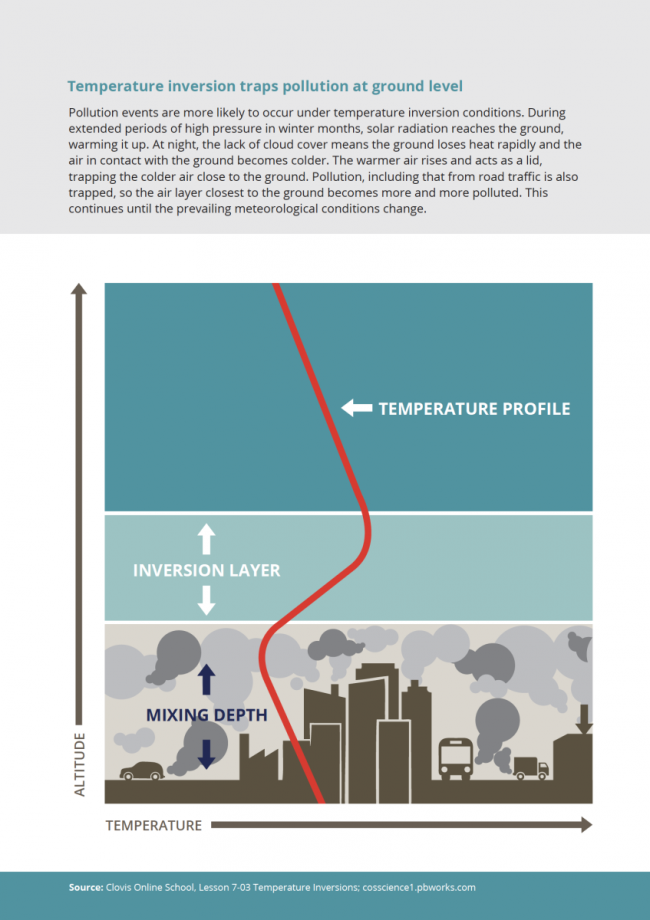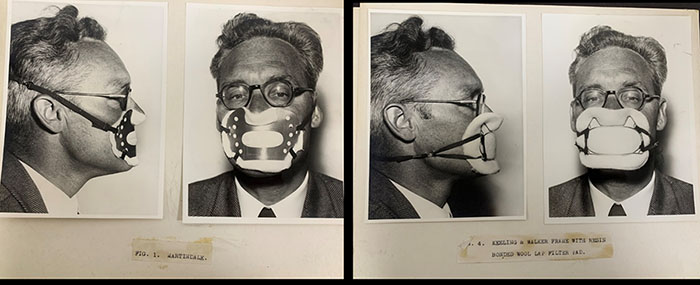
Air pollution was high or very high across urban areas of Yorkshire and NE England on Wednesday, thanks to a strong high pressure inversion acting as a lid and trapping pollutants from traffic and other sources at the surface, with little wind to remove it. The pollution likely exacerbated from overnight with fireworks and bonfires too.
Air pollution can often be worse in winter, especially under high pressure, as cold air is denser and more stable than warmer air, so acts like a blanket, so pollutants aren’t as free to disperse and escape. Cold air also moves slower, so pollution tends to linger, particularly in valleys where cold air becomes trapped. But a high pressure inversion also traps cold air at the surface, which can exacerbate pollution.

Normally, temperatures decrease as altitude increases. In an inversion, however, the temperature in a specific layer of the lower troposphere increases with altitude. This results in the lower-altitude air layers being colder than the higher ones. Inversions are normally produced by high pressure systems, which are associated with large-scale subsidence or sinking motion. As the air descends, it warms and becomes drier. Over time, that descending air layer may become warmer than the layers below it, especially where clear skies at night allow radiative cooling at the surface, this sets up a warm layer over cold layer, or an inversion.

The concentrations of pollutants in the air vary over the course of the day, and over the seasons of the year. Sometimes a period of high air pollution may occur – commonly referred to as an air pollution episode. This can last up to several days and may extend over a large area. In some cases there are high concentrations of many pollutants at the same time, but in others only one pollutant may be affected.
These air pollution episodes are caused in different ways: during the coldest winter months, stable weather conditions under a high pressure inversion can trap pollutants close to their sources and prevent their dispersion. This leads to high concentrations building up over several days.
In the 1950's and 1960's, domestic coal burning, with their high levels of black smoke and sulphur dioxide, was responsible for the 'pea-souper' fogs or smog in big cities such as London during periods of high pressure. The pollutants in the air act as catalysts for fog, as water clings to the tiny particles to create polluted fog, or smog.
 The Great Smog of 1952 - The National Archives blog This year marks the 70th anniversary of the Great Smog of London, which occurred between 5-9 December 1952. The event was of great significance in the history of public health, resulting in the passing of the Clean Air Act of 1956, which regulated the use of air pollutants. The type of fog, containing poisonous sulphur […] The National Archives blog
The Great Smog of 1952 - The National Archives blog This year marks the 70th anniversary of the Great Smog of London, which occurred between 5-9 December 1952. The event was of great significance in the history of public health, resulting in the passing of the Clean Air Act of 1956, which regulated the use of air pollutants. The type of fog, containing poisonous sulphur […] The National Archives blog The major historic smog of the 1950's occurred on the four days between 5 and 9 December 1952, when smoke measurements taken at the National Gallery in London suggest that the concentration reached 14 mg/m3 - which was 56 times levels normally experienced at the time. Cold conditions during early December 1952 meant that the residents of London were burning large quantities of coal in their homes to keep warm, central heating wasn’t a thing then. The resultant smoke was trapped by a high pressure inversion and as the air was moist too, a thick and deadly smog developed and didn’t budge for 4 days. About 4,000 people were known to have died as a result of the fog, and many more suffered from breathing problems
Cattle at Smithfield had been asphyxiated by the smog, while travel was disrupted for days. Following the Great Smog, a series of laws were brought in to avoid a repeat, including the Clean Air Acts of 1956 and 1968.
Today, however, a major source of many air pollutants in most UK cities is road traffic, and high concentrations of nitrogen oxides, particles (PM10), hydrocarbons such as benzene are usually observed during high pollution episodes. Around bonfire night and the addition of Diwali celebrations this year, fireworks and bonfires have been an additional source of pollution in recent days. All these pollutants emitted coinciding with high pressure trapping the pollutants at the surface in some areas.
In summer, a completely different type of pollution episode may occur. During hot and sunny weather, high levels of ozone can be produced, sometimes accompanied by nitrogen dioxide or particles (PM10). The pollution that causes the episode can often travel long distances - sometimes from other parts of Europe, such as the Low Countries via easterly winds. When pollutants drift long distances they undergo a complex series of chemical reactions, driven by sunlight, which produce high levels of ozone and other pollutants.
Source: DEFRA UK Air
Fortunately, air pollution looks to remain generally low today and through the weekend into early next week, despite anticyclonic conditions, with gentle breezes dispersing pollutants. Just isolated pockets of moderate pollution in towns and cities.
Loading recent activity...